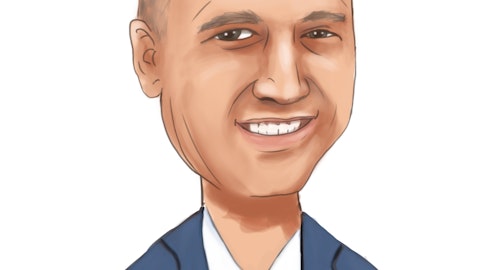Morgan Gasior: As far as credit quality is concerned, credit quality is stable. As you can see, the numbers stayed stable from quarter-over-quarter. Our federal cases are filed with the prime contractors and we’re in the final stages of all the approvals and reviews, so nothing to report there other than progress in the process. Probably worth noting that, credit quality net of the federal was 31 basis points or so at the end of the year. And of that, the one equipment deal we have the equipment. It’s being listed for sale now. We’re going to start a marketing process pretty much next week. We hope to move it, during the next several — couple of months. We’re not going to give it away, but we want to put an aggressive marketing and disposition program together.
So, if you took those three cases out, we were down to something like 15 18 basis points. And if you look at the distribution, the real estate portfolio continues to perform well. Of the $200 million in Equipment Finance payments, we received during the year, $96 million came out of the government portfolio. So it did what it was supposed to do other than the two federal credits that we dealt with. And going forward, things seem relatively stable. We’ll have a couple of the special mention or substandard credits that if they improve their performance then great we’ll keep them. And if they don’t, then we’ll start exiting them. These are primarily working capital lines of credit, so they are self-liquidating in that context. But we felt pretty good about where credit ended at the end of the year.
Obviously, you know, that we don’t have the material exposures to office in the portfolio. In fact, we had one office exposure pay off in fourth quarter. So the strength of the portfolio in multifamily and our lower-risk commercial real estate seems to be serving us well.
Brian Martin: Got you. Okay. And maybe just the last one, then I’ll pass it on to someone else, just the expense guide it looked like you hired a few folks and just a little bit — maybe still a little bit of noise in there on the credit quality expense. So just kind of thinking about that expense kind of — I wouldn’t call it nonrecurring, but just on the credit expense kind of moderating and then just the new level kind of new run rate with some of the hires you made this quarter? Thanks.
Morgan Gasior: Well, I would say, if we’re looking at expenses next year somewhere around $41 million to $42.5 million. I know that’s a fairly broad range, but there’s a couple of factors there. One is, the expense that’s reported on compensation, is in some ways a function of loan originations. So, if we have higher loan originations and particularly for new loans, and new exposures then a certain percentage of the compensation related to that especially, incentive compensation is part of the deferral process. If you have lower originations, then the expense drops to the bottom line in that period. So that will be a factor, in terms of the, what we’ll call GAAP compensation expense reported. We do expect to sell the branch facility that’s been under contract.
We’re down to the final State of Illinois, approval that’s due I think in the next couple weeks. So, we hope to close that transaction in March and get that off the books. And then the other expense on legal, we are in the hopefully, last stages of the claims process. Every time we get a comment or a review, it adds a little more on the bill. But I would expect that especially year-over-year to decline obviously. And given where credit quality stands right now, we would not expect it to recur. But of course, we’ll just have to watch and wait and see. So that’s why we think expenses of $41 million to $42.5 million seem reasonable. It’s just going to be primarily a function of how well we originate, because that will affect the GAAP number. And then two, we’ll see some variability in marketing expense.
We’ll talk — we need to talk to new customers and broaden the base, and that is just a marketing expense. So if we do save money in one place or another, we’d like to deploy it into marketing to keep the growth going on the loan side and the commercial deposit side. And I’d say, the other variable in expenses is, inflation is still a bit with us. When we see technology contracts and maintenance contracts come in and even fixed asset maintenance contracts, we’re still seeing high single-digit, low double-digit increases in some of the stuff. And in some cases, you don’t have much choice. So, anything, we save in terms of efficiencies, sometimes is offset by some of these third-party agreements that you have to have the assets. There’s really no choice in the matter, and you’re kind of a sitting duck.
I’m sure every business in America feels like that. But that is some of the variables. So, $41 million to $42.5 million seems a reasonable range for us. As I said, the gross compensation level should be static. It’s a question of how the originations volume is what we report on a quarter-over-quarter basis.
Brian Martin: Got you. Okay. Well, thanks for taking the questions.
Morgan Gasior: Appreciate your time.
Operator: Thank you. One moment for our next question. And our next question will come from the line of Henry Waldeck [ph] as a private investor. Your line is open.
Unidentified Analyst: Good morning, Morgan. How are you?
Morgan Gasior: Good morning.
Unidentified Analyst: Happy Groundhog’s Day. Brian asked most of my questions, but I just have some commentary and a couple of generic questions. While our stock price has improved a bit since the last quarter and the last time we spoke that’s semi-good news I hope. Morgan, I hope you’re doing all you can to help us old-time shareholders that have been with you for the last 18 years. That being said, I have a kind of generic and a holistic question here. Interest rates may be trending lower in the second half of the year. So, is your team considering or looking at any strategical actions that make sense at this time, as we look forward to the potential for future flat rate cuts? Like, for example, how much would our 25 basis point cut or a 50 basis point cut have on your bottom line? Thank you.
Morgan Gasior: Okay. Well, certainly, as I said earlier, we’ve already seen a certain amount of decline in the United States Treasury curve. And we’ve been taking advantage of that throughout the last quarter or so by rolling some cash into medium to short-medium-term CD investments, which have currently been yielding better than Fed funds so north of 540. The point of focusing on the investment grade and the corporate Equipment Finance is the same strategy larger context pick up even more yield if we can maybe not a great spread the Fed funds today. But if we can pick up anywhere between 35 to 50 basis points on the low end, maybe 100 basis points on the high end over current Fed funds then nine to 12 months from now if the Fed does cut 75 to 100 points, and the Treasury curve follows that further, so that you’re looking at five-year treasuries in the 3.18% range, we’ll have protected by the interest income side.
And at the same time, we should therefore, get some benefit from declines in interest expense. So those are the two drivers of an improvement in net interest margin is as I said earlier protect the interest income side, expand it through reinvestment, and then do it within a reasonable duration so that even into 2025 and 2026 should we go down to a lower environment a set of higher for longer, we would enjoy the protection of those assets at today’s yields, which will look phenomenal compared to the yields of nine months or a year from now.
Unidentified Analyst: Thank you. Morgan in the last quarter, you mentioned the possibility of reaching and sustaining earnings of $1.24. Is that still possible in 2024 with a tepid Q4 in 2023?
Morgan Gasior: I think it’s possible as we get towards the second half of the year. To some degree, as I said earlier, if we have stability in the balance sheet and we’re not giving up interest income due to a decline in interest-earning assets that’s certainly helpful. The ability to reinvest the securities especially later this year into higher yields will certainly be helpful. The ability to have higher yields on originations and more efficiency in the income statement as a result of that will certainly help. And if we just have lower overall expenses or stability in expenses that will help. So, yes, we think that as we get towards the second half and if we’re able to get the originations up where we want them to go then the trend towards back into the low $0.20s and then the $0.25 a share third quarter, fourth quarter and then hold it that’s the whole point of reinvesting in the medium-term is if we can hold that interest income level we should get the benefit of some reduction in interest expense over time.
And that should not only be sustainable, but we should be able to build on it because we will have cash flows going into 2025 as well. But at that point we should have materially lower interest expense and get the benefit of further expansion in net interest margin.
Unidentified Analyst: Thank you. Morgan, just one quick comment here I like the improvement in NPAs and your book value of $12.45 — geez 1.2 times 12.45. That’s like happy land. And 1.3 times book of 12.45 that’s like Nirvana. I’ll pause and let my fellow shareholders chip in. Thank you.
Operator: Thank you. One moment for next question. And our next question will come from the line of Stephen Buckman from Buckman Capital [ph]. Your line is open.
Unidentified Analyst: Thank you. Good morning, Morgan.
Morgan Gasior: Good morning.
Unidentified Analyst: I have been a shareholder that took part in the conversion 18, 19 years ago. And I have a more holistic question as well. And that is what is the role of the Board of Directors? And I’m going to refer you to a conference call comment you made on May 2, 2022. And what you said I’m quoting is, “Well, first of all, I think we’re in a position now where our goal for the third quarter and fourth quarter is to sustain right around $0.23 to $0.26 a share. So I’m going to try to hit that $1 per share in our third quarter and fourth quarter.” This is 2022. And then beginning next year the goal would shift to getting into the $0.30s or somewhere between $0.30 and $0.34. I could go on but the fact is 18 years later the only guy who’s made out here is you. Our book value, our stock price, our franchise value are all lower than they were in 2004 when you converted. What is the role of the Board of Directors in terms of your underperformance during this time?



